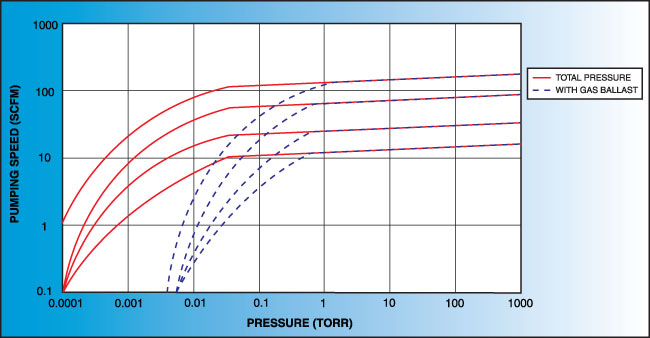Pumping Speed Definition
The formal definition of pumping speed is:
- The ratio of the throughput of a given gas to the partial pressure of that gas at a specific point near the inlet port of the pump.
Pumping Interpretation
With less formality, but perhaps more clarity, pumping speed is a measure of the pump's ability to permanently remove gas from its inlet port.
Pumping Speed units
Pumping speed is a volumetric flow measured in units of volume per unit time, specifically:
- liters per second: L/s
- liters per minute: L/m
- cubic feet per minute(cfm)
- cubic meters per hour (m3/h)
As with conductance, expressing pumping speed as volumetric flows has the benefits that pumping speed and conductances can be combined by simple math.
Pumping Speed Curved
Various standards organizations in the United States, Europe, and Asia have specified methods for measuring pumping speed. As far as we are aware, all suggest capping the pump with a small volume dome at its inlet port and monitoring the pressure at various gas flow rates into the dome (from a calibrated mass flow controller). The results are plotted as pumping speed vs. pressure as shown in the chart below.

Because a pump's pumping speed is measured under ideal conditions, its numerical value will be unobtainable in a practical system — the connection between any pump and any chamber affects the pumping speed (see Effective Pumping Speed).
Displacement and Capacity
Unfortunately, many mechanical pump manufacturers quote a value called free air displacement or capacity for their pumps.
The units are volumetric flow rate and the value is easily mistaken for a measured pumping speed. However, displacement/capacity appears to be a theoretical pumping speed the pump might have if the gas:
- had no mass or viscosity
- negotiated the entrance port and constrictions into the pumping mechanism instantaneously
- and did so without turbulence or boundary layer effects.
Why pump manufacturers indulge in such an exaggeration is unknown.
It only confuses those attempting vacuum calculations. We strongly suggest displacement/capacity values be ignored or, in the absence of a measured pumping speed, multiplying displacement by ~0.75 to get an approximation of the real pumping speed.



